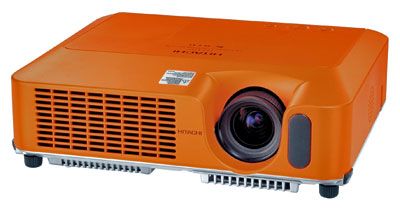Are people stealing your Data Projectors?
Get an orange one.

http://www.techdigest.tv/2006/03/hitachi_launche.html
More amusing take on the subject
http://www.engadget.com/2006/03/28/hitachis-ed-x10-educational-projector/
Are people stealing your Data Projectors?
Get an orange one.

http://www.techdigest.tv/2006/03/hitachi_launche.html
More amusing take on the subject
http://www.engadget.com/2006/03/28/hitachis-ed-x10-educational-projector/
You can use the VLE as a “home” for non-classroom based activities. These can be undertaken by students at home, in the library or at a time and place to suit the learner.
 I am a great fan of Comic Life which comes free on most new consumer Macs and was pleasantly surprised to see that Plasq are working on a version for Windows.
I am a great fan of Comic Life which comes free on most new consumer Macs and was pleasantly surprised to see that Plasq are working on a version for Windows.
The second Comic Life for Windows Beta is now available for download – with ongoing thanks to our encouraging and patient beta-testers. Thank you all for your kind words and helpful feedback!
This latest beta includes many small improvements relating to installation, usage and stability.
You can find the download, new beta serial number and release notes in this forum post here.
I am attending the information day on Molenet.
The Mobile Learning Network (MoLeNET) is a unique collaborative approach to encouraging, supporting, expanding and promoting mobile learning, primarily in the English Further Education sector, via supported shared cost mobile learning projects.
Collaboration at UK national level involves colleges and the Learning and Skills Council (LSC) sharing the cost of projects introducing or expanding mobile learning and the Learning and Skills Network (LSN) providing a support programme.
There is some interesting ideas here, and the £6m for capital expenditure will provide a definite boost to mobile-learning in the FE sector.
Currently listening to Lilian Soon giving a very interesting and informative presentation on m-learning.
Sub £500 educational UMPC
Was sent an e-mail regarding a new UMPC for the education market, the RemTech UM650.

Looks interesting.
Found a useful shortcut, if you are using Word and want to repeat your last action then pressing F4 will make this happen.
I have been writing some guides and needed to resize the screenshots, I was doing this for each one, but now, do one, click the next, press F4, click the next, press F4 and so on.
Saving time with this one.
JISC Legal will be hosting a free to view webcast on 18 July 2007 on Business and Community Engagement – The Legal Issues. The aim of this webcast is to raise awareness of the legal issues involved in BCE activities (for instance, copyright) and show how JISC Legal, through its guidance publications and case studies, can assist colleges and universities with these issues. There will also be contributions from the other JISC Advisory Services (JISC infoNet , Netskills , TechDis and TASI) to show how they can use their expertise to support institutions with their BCE activities.
The webcast is directed at UK further and higher education staff working in areas related to knowledge transfer, work based learning, community links, outreach, CPD, employer engagement, wider participation, and lifelong learning.
You can find further information about the programme and how to access the webcast by visiting the webcast section of the JISC Legal website.
I am attending an RSC SW Event at City of Bristol College, e-Learning Gathering Momentum. Interesting for me as I am back at City of Bristol college where I was a Business lecturer for many years. Meeting old colleagues has been nice.
At the moment Angela Harvey from the RSC SW is introducing the door, but is also mentioning the CAMEL approach.
Should be an interesting and informative day.
It is very useful for a student to undertake reading or similar before the lesson, it prepares them and gives a background to the topic of the session.
Often in a course you may require students to read a chapter from a textbook in preparation for the next session.
You can do something similar with resources on a VLE.
Resources you could ask your students to read or go through could include one or more of the following:
• NLN Learning Object;
• resource from Ferl/QIA website;
• resource downloaded from the JISC JORUM repository;
• a specific web link (or selection of web links);
• a resource you have created and uploaded to the VLE;
• a series of questions to ascertain the previous knowledge.
One of the advantages of a VLE is that the use of the resource by learners can be tracked so you will have an idea of who has actually done what you asked.
A specific example of this to show how you can do this.
For the GCE AS History you need to study the Russian Revolution.

There are a range of NLN Learning Objects which cover History and one covers 1917 – the year of revolution: The failure of the provisional government and the success of the Bolsheviks.
Prior to starting the topic you could ask your students to look at and read the learning object on the VLE in the same way you may get them to read a chapter from a book.
They will then be able to have a background to Russian Revolution of 1917 which will enable you to focus on the issues rather than starting from scratch.
Is this what Second Life is coming too?